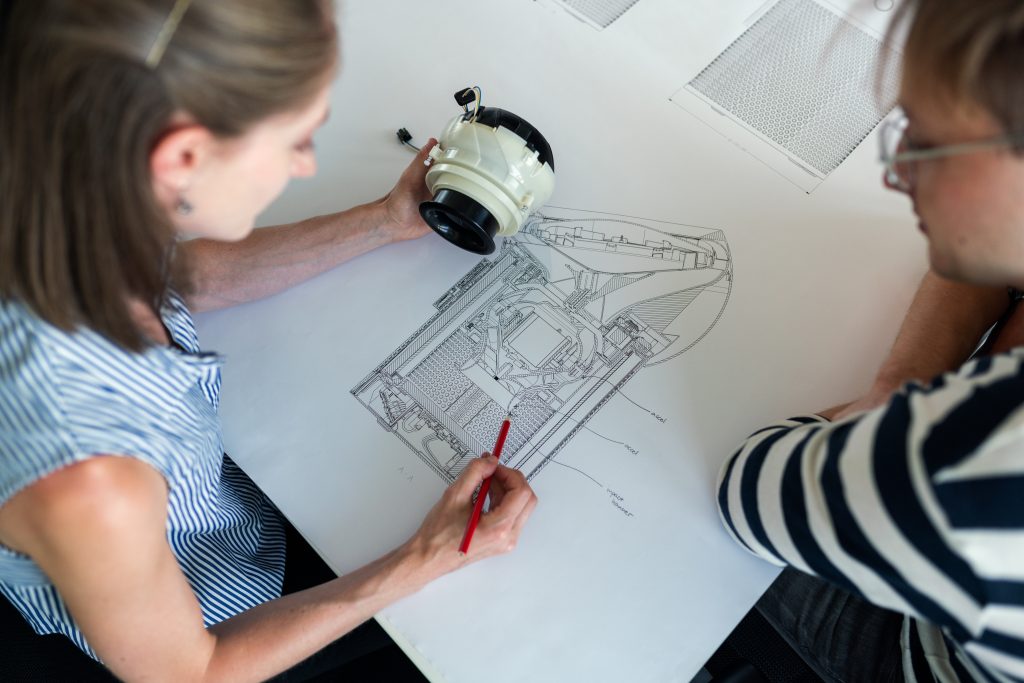In today’s rapidly evolving world, innovation has become the lifeblood of successful businesses. It is no longer sufficient to simply deliver a product or service; companies must constantly strive to push boundaries, challenge conventional thinking, and create solutions that truly resonate with their customers. However, true innovation is not an easy feat to achieve. It requires a deep understanding of customer needs, a willingness to take risks, and above all, a commitment to continuous improvement. In this article, we will explore the art of innovation and provide practical tips on how to build products that your customers will not only like but absolutely love. So strap in and get ready to unleash your inner innovator!
Why innovation is crucial in today’s market
Innovation is crucial in today’s market because it offers businesses a competitive edge and allows them to stand out from their competitors. In a world where customers are constantly bombarded with choices, it is not enough to simply offer the same products or services as everyone else. Businesses need to continuously think outside of the box and come up with new ideas that keep their customers engaged and excited.
Furthermore, innovation helps businesses stay relevant in an ever-changing market. Consumer preferences and needs evolve over time, and companies that fail to adapt will quickly find themselves left behind. By consistently innovating and keeping up with the latest trends and technologies, businesses can ensure they are providing their customers with products that meet their current needs while also anticipating future ones.
Moreover, innovation drives growth. It opens up new possibilities for revenue generation by allowing businesses to enter new markets or expand their existing offerings. It also improves efficiency through process innovation, helping companies streamline their operations and reduce costs.
Overall, innovation is no longer just a nice-to-have; it is essential for survival in today’s fast-paced market. Businesses must embrace a culture of constant improvement and invest in research and development if they want to build products that truly resonate with their customers. By doing so, they will not only meet customer expectations but exceed them – creating loyal followers who love what they have to offer.

Understanding your customer’s needs and pain points
Understanding your customer’s needs and pain points is the foundation of successful product development. It’s not enough to simply have a great idea; you need to understand who your customer is, what problems they are facing, and how your product can solve those problems. This requires deep empathy and the ability to put yourself in their shoes.
One way to gain insights into your customer’s needs is through direct observation and interaction. By spending time with your target audience, listening to their challenges, and observing how they navigate their daily lives, you can uncover pain points that may not be immediately obvious. These insights can then be used to inform the design and development of solutions that truly meet the needs of your customers.
Additionally, it’s important to remember that customer needs are not static. They evolve over time as circumstances change and new technologies emerge. To stay ahead of the curve, it’s crucial to constantly engage with your customers through surveys, interviews, or even social media platforms. This ongoing dialogue will help you stay attuned to their changing pain points and ensure that your products continue to provide value.
In conclusion, understanding your customer’s needs and pain points is an essential step in building products that resonate with them. By empathizing with their experiences and continuously seeking feedback, you can create solutions that not only meet their current needs but also anticipate future ones.
Encouraging a culture of innovation within your organization
One of the biggest challenges organizations face in today’s fast-paced business landscape is the need to constantly innovate and stay ahead of the competition. However, building a culture of innovation within your organization can sometimes feel like an uphill battle. Encouraging employees to think outside the box and take risks can be difficult when there is a fear of failure or a lack of support from management.
To foster a culture of innovation, it is important to create an environment where ideas are welcomed and encouraged. This starts with leadership setting the example by being open to new ideas and actively seeking input from all levels of the organization. By creating channels for communication and providing resources for experimentation, organizations can empower their employees to come up with creative solutions to problems.
Furthermore, organizations should reward and recognize those who showcase innovative thinking. This could include implementing incentive programs or hosting regular brainstorming sessions where innovative ideas are acknowledged and celebrated. When employees see that their creativity is valued and appreciated, they will be more motivated to continue pushing the boundaries of what is possible.
In conclusion, fostering a culture of innovation requires intentional effort from leadership as well as buy-in from every level within the organization. By providing an environment that supports creativity, encouraging risk-taking, and rewarding innovative thinking, companies can build a foundation for success in today’s rapidly evolving business landscape. Remember that innovation often comes from unexpected places; by nurturing this mindset throughout your organization, you are sure to make products your customers love.

The importance of user feedback in product development
One could argue that user feedback is the lifeblood of product development. After all, who knows better about a product’s strengths and weaknesses than those who actually use it? Incorporating user feedback into the product development process not only helps ensure that users’ needs and desires are met, but it also enhances customer satisfaction and loyalty. By actively seeking and engaging with user feedback, companies can build products that truly resonate with their target market.
Not only does user feedback provide valuable insights into what users want, but it can also uncover hidden opportunities for innovation. Users may identify unmet needs or suggest new features that can give a product a competitive edge in the market. By tapping into this wealth of information, companies have the potential to push beyond incremental improvements and deliver truly transformative products that disrupt industries.
In today’s fast-paced digital age, where customer expectations are constantly evolving, regular feedback cycles become essential for maintaining a competitive advantage. The iterative nature of incorporating user feedback allows for continuous improvement based on real-world usage data rather than mere assumptions or guesswork. By embracing an agile mindset and iterating on products based on frequent user feedback loops, companies can adapt quickly to changing trends and preferences, staying ahead of the curve in an ever-evolving marketplace.
Iterative design: constantly improving and adapting your products
Iterative design is the key to creating products that truly resonate with your customers. By constantly improving and adapting, you can ensure that your offerings stay relevant in a fast-paced market. This approach allows you to respond to customer feedback, identify pain points, and make necessary adjustments along the way.
One of the core advantages of iterative design is its ability to reduce risk. Rather than investing time and resources into launching a fully developed product right away, an iterative approach allows for small-scale tests and incremental improvements. This not only helps in identifying potential flaws or gaps but also gives you an opportunity to gather valuable insights from your early adopters.
Furthermore, iterative design promotes innovation by fostering a culture of constant learning within your organization. It encourages creativity and flexibility as teams are encouraged to experiment with new ideas without fear of failure. Through this process, not only will you develop better products but also enable continuous growth for both your company and its employees.
In conclusion, adopting an iterative design methodology empowers businesses to refine their products based on user feedback while reducing risk and promoting innovation. By constantly improving and adapting, companies can create offerings that truly cater to the needs and desires of their customers.

Embracing failure as a stepping stone to success
Embracing failure is not just about accepting that mistakes happen; it’s about recognizing the invaluable lessons that failure brings. When we view failure as a stepping stone to success, we create an environment where innovation flourishes. In fact, some of the greatest discoveries and inventions in history have arisen from failed attempts and setbacks.
Failure allows us to gain new perspectives, challenge assumptions, and refine our ideas. It forces us to think outside the box, learn from our mistakes, and iterate until we achieve greatness. Instead of being discouraged by failures, we should see them as opportunities for growth and improvement.
Embracing failure requires a shift in mindset – it means being willing to take risks, make bold decisions, and learn from both successes and failures. By encouraging a culture of experimentation within our teams and organizations, we can foster an environment where creativity thrives and breakthrough innovations are born. So let’s shift our perspective on failure – it’s not something to be feared or avoided but rather embraced as an essential part of the journey towards success.
Conclusion: Innovate or become irrelevant
In today’s fast-paced and ever-evolving world, innovation has become a necessity for businesses to survive and thrive. As technology continues to advance at an exponential rate, customer expectations are also evolving. What was once groundbreaking and revolutionary quickly becomes the norm, making it crucial for companies to continuously innovate or risk becoming irrelevant.
One of the key reasons why innovation is so important is because it allows businesses to stay ahead of their competitors. By constantly pushing the boundaries and bringing new and improved products to market, companies can differentiate themselves from others in their industry. This not only helps attract new customers but also keeps existing ones loyal by providing them with value-added experiences.
Moreover, innovation drives business growth. It opens up new opportunities for expansion into untapped markets or the creation of entirely new product categories. Companies that fail to innovate not only miss out on these growth prospects but also put themselves at risk of being overtaken by more innovative competitors.
To succeed in today’s dynamic marketplace, businesses must embrace a culture of innovation. They need to foster creativity and encourage their employees to think outside the box. By doing so, they can harness the power of innovation and secure their position as leaders in their industry – staying relevant for years to come.
Remember: Innovate or become irrelevant – it’s as simple as that!


